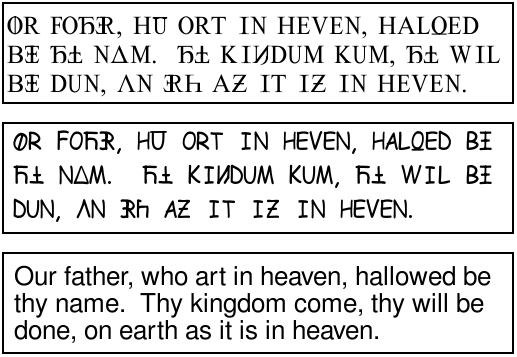
Unifon
Encyclopedia

Phonemic orthography
A phonemic orthography is a writing system where the written graphemes correspond to phonemes, the spoken sounds of the language. In terms of orthographic depth, these are termed shallow orthographies, contrasting with deep orthographies...
for English
English language
English is a West Germanic language that arose in the Anglo-Saxon kingdoms of England and spread into what was to become south-east Scotland under the influence of the Anglian medieval kingdom of Northumbria...
designed in the mid-1950s by Dr. John R. Malone, a Chicago economist and newspaper equipment consultant. It was developed into a teaching aid to help children acquire reading
Reading (process)
Reading is a complex cognitive process of decoding symbols for the intention of constructing or deriving meaning . It is a means of language acquisition, of communication, and of sharing information and ideas...
and writing
Writing
Writing is the representation of language in a textual medium through the use of a set of signs or symbols . It is distinguished from illustration, such as cave drawing and painting, and non-symbolic preservation of language via non-textual media, such as magnetic tape audio.Writing most likely...
skills. Like the pronunciation key
Pronunciation respelling for English
Pronunciation respelling is a notation used to convey the pronunciation of words, in a language, such as English, which does not have a phonemic orthography....
in a dictionary, Unifon matches each of the sounds of spoken English with a single symbol. The method was tested in Chicago, Indianapolis, and elsewhere during the 1960s and 1970s, but no statistical analysis of the outcome was ever published in an academic journal, and interest by educators has been limited, although a community of enthusiasts continues to publicize the scheme and advocate for its adoption.
Unifon alphabet

History
Under a contract with the Bendix CorporationBendix Corporation
The Bendix Corporation was an American manufacturing and engineering company which during various times in its 60 year existence made brake systems, aeronautical hydraulics, avionics, aircraft and automobile fuel control systems, radios, televisions and computers, and which licensed its name for...
, Dr. John R. Malone created the alphabet as part of a larger project. When the International Air Transport Association
International Air Transport Association
The International Air Transport Association is an international industry trade group of airlines headquartered in Montreal, Quebec, Canada, where the International Civil Aviation Organization is also headquartered. The executive offices are at the Geneva Airport in SwitzerlandIATA's mission is to...
selected English as the language of international airline communications in 1957, the market that Bendix had foreseen for Unifon ceased to exist, and Malone’s contract was terminated. According to Malone, Unifon surfaced again when his son, then in kindergarten, complained that he couldn’t read yet. Malone recovered the alphabet to teach his son.
Beginning before 1960 and continuing into the 1980s, Margaret S. Ratz used Unifon to teach first-graders at Principia College
Principia College
Principia College is a four-year private co-educational liberal arts college in Elsah, Illinois. The campus sits on bluffs overlooking the Mississippi River between Alton and Grafton, located about thirty miles north of St. Louis. In 1934, Principia College graduated its first class as a full...
in Elsah, Illinois. By the summer of 1960, the ABC-TV
American Broadcasting Company
The American Broadcasting Company is an American commercial broadcasting television network. Created in 1943 from the former NBC Blue radio network, ABC is owned by The Walt Disney Company and is part of Disney-ABC Television Group. Its first broadcast on television was in 1948...
affiliate station in Chicago
Chicago
Chicago is the largest city in the US state of Illinois. With nearly 2.7 million residents, it is the most populous city in the Midwestern United States and the third most populous in the US, after New York City and Los Angeles...
produced a 90-minute program in which Dr. Ratz taught three children how to read, in “17 hours with cookies and milk,” as Malone described it. In a presentation to parents and teachers, Dr. Ratz said, “Some have called Unifon ‘training wheels for reading,’ and that’s what it really is. Unifon will be used for a few weeks, or perhaps a few months, but during this time your child will discover there is a great similarity between Unifon and what he sees on TV screens, in comics or road signs, and on cereal boxes. Soon he finds with amusement that he can read the ‘old people’s alphabet’ as easily as he can read and write in Unifon.”
During the following two years, Unifon gained national attention, with coverage from NBC’s Today Show and CBS's On the Road with Charles Kuralt
Charles Kuralt
Charles Kuralt was an American journalist. He was most widely known for his long career with CBS, first for his "On the Road" segments on The CBS Evening News with Walter Cronkite, and later as the first anchor of CBS News Sunday Morning, a position he held for fifteen years.Kuralt's "On the Road"...
(in a segment called “The Day They Changed the Alphabet”).
In 1981, Malone turned over the Unifon project to Dr. John M. Culkin
John M. Culkin
John M. Culkin, SJ, PhD , leading media scholar and critic, educator, writer and consultant.-Early life and education:John Culkin was born in 1928 to an Irish-Catholic family from Brooklyn. He and his brother Gerald attended Xavier High School, an elite Jesuit College Preparatory High School, in...
, a media scholar who was a former Jesuit priest and Harvard School of Education graduate. Culkin wrote numerous articles about Unifon, including several in Science Digest.
In 2000, the Unifon web site, http://www.unifon.org, was created by Pat Katzenmaier with much input from linguist Steve Bett, and has served since then as a central point for organization of Unifon-related efforts.
Unifon for Native American languages
In the 1970s and 1980s, a systematic attempt was made to adapt Unifon as a spelling system for several Native American languages. The chief driving force behind this effort was Tom Parsons of Humboldt State UniversityHumboldt State University
Humboldt State University is the northernmost campus of the California State University system, located in Arcata within Humboldt County, California, USA. The main campus, nestled at the edge of a coast redwood forest, is situated on Preston hill overlooking Arcata and with commanding views of...
, who developed spelling schemes for the Hupa
Hupa
Hupa, also spelled Hoopa, are a Native American tribe in northwestern California. Their autonym is Natinixwe, also spelled Natinookwa, meaning "People of the Place Where the Trails Return." The majority of the tribe is enrolled in the federally recognized Hoopa Valley Tribe; however, some Hupa are...
, Yurok
Yurok language
Yurok is a moribund Algic language. It is the traditional language of the Yurok tribe of Del Norte County and Humboldt County on the far North Coast of California, U.S., most of whom now speak English...
, Tolowa
Tolowa language
The Tolowa language is a member of the Pacific Coast subgroup of the Athabaskan language family. It is spoken by Tolowa Indians in southern Oregon and northern California. There are only a handful of remaining fully fluent native speakers...
, and Karok languages, which were then improved by native scholars. In spite of skepticism from linguists, years of work went into teaching these schemes, and numerous publications were written using them. In the end, however, the idea never caught fire, and once Parson left the university, the impetus faded; other spelling schemes are currently used for all of these languages.
Adoption
Although Unifon was made available to a number of schools in the early 1960s, it was overshadowed by another initial teaching alphabetInitial Teaching Alphabet
The Initial Teaching Alphabet was developed by Sir James Pitman in the early 1960s...
, Pitman's Augmented Roman. This came to be known as the i/t/a and was supported with $20 million in research grants in the US and the UK. By comparison, Unifon had relatively little outside support. Various grants to the Unifon Foundation totaled around $1 million.
To complicate matters Unifon was completely at odds with conventional wisdom. Most educators doubted that preschool children were ready for reading let alone writing. The Unifon classes demonstrated that once the kids learned the 40 sound-symbol correspondences, they started writing and were code literate in less than 3 months.
The i/t/a allowed teachers to teach as they had always taught except their basal readers would now be transcribed into Pitman's augmented Roman. Children progressed through their transcribed readers twice as fast as their peers using traditional readers. However, in the 3rd year when students transitioned to traditional spelling, they lost most of their advantage. The i/t/a or initial teaching alphabet
Initial Teaching Alphabet
The Initial Teaching Alphabet was developed by Sir James Pitman in the early 1960s...
, failed to accelerate conventional literacy.
While i/t/a students learned word-signs, 50% never overlearned the code. Half of the i/t/a/ trained students could not spell words that were not included in the controlled vocabulary of their readers. By contrast, all of the Unifon trained students could string together sound-signs for any word they could pronounce and pronounce any Unifon spelling by the 3rd month. They were code literate. They could comprehend transcribed text as well as they could comprehend the text that was read to them.
Although upper case Unifon did not resemble traditional spelling nearly as much as lower case i/t/a with its ligatured digraphs, children were still able to make the transition.
Downing
Downing
- Places :* Downing Street, London, UK** 10 Downing Street, London, UK** 11 Downing Street, London, UK** 12 Downing Street, London, UK* Downing, Wisconsin, USA* Downing, Missouri, USA* Downing College, Cambridge, UK** Downing Site, Cambridge, UK...
had predicted that if the code was overlearned, the skills developed learning the simple orthography would transfer. The i/t/a failed to accelerate literacy because at least half of the students did not overlearn the code and because the teaching method used was designed to promote whole-word recognition. Students who learned that "show your shoes" was spelled "[sh][oe] ywr [sh][oo]z" had some unlearning to do. Simulated Unifon: $Ó Y3R $ÚZ.

